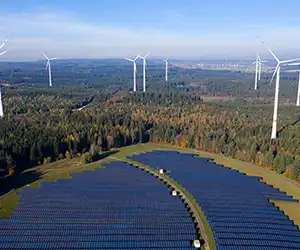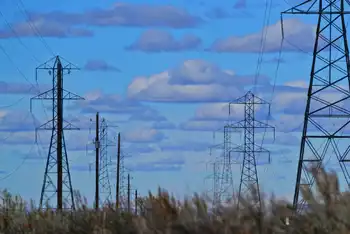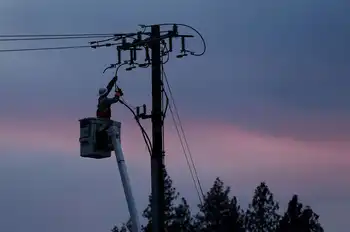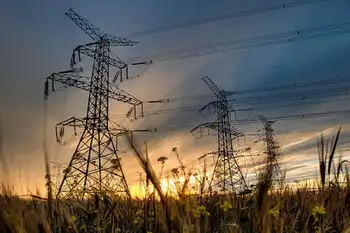Wind power development begins on public lands
By The Oregonian
High Voltage Maintenance Training Online
Our customized live online or in‑person group training can be delivered to your staff at your location.

- Live Online
- 12 hours Instructor-led
- Group Training Available
"They say that in the summer it shouts, but in the winter it screams," Elon Hasson said of the wind on southeast Oregon's Pueblo Mountains.
That screaming is the siren song in a new gold rush underway on public lands in Oregon and across the West.
And the red and white wind-testing tower Hasson stands below is a stake his company, Horizon Wind Energy, has planted to mark its claim.
Several things are pushing wind prospectors into places like Harney County's Pueblo Mountains: state rules requiring utilities to buy more renewable power; an Obama administration eager to enable green energy development on federally managed lands; and the fact that many of the state's best private wind sites are already taken.
"It's at our doorstep," said Fred O'Ferrall, state chief for lands and minerals resources for the Bureau of Land Management, the federal steward for a quarter of all the land in Oregon.
Rows of tall turbines have already remade the landscape on wheat farms and ridgelines on private land around the region. But so far there have been no wind farms built on public land in the Northwest. That's about to change.
In 2006 the BLM received six right-of-way applications for wind testing in Oregon and Washington. The number last year was four times that — 24.
Wind farms in relatively untrammeled public lands present a number of potential problems while pitting two environmental concerns — the quest for green power to combat climate change, and more traditional conservation of undeveloped land — against each other.
Although Oregon's dry side was bypassed by the oil and gas boom that roiled the West in recent years, it's clear that won't be the case with wind. That could change the view from atop Steens Mountain or on Interstate 84 while driving toward Boise. But it also portends some bitter fights over who gets to use publicly owned land and for what purpose.
And a lot of that fighting could center on a showy, chickenlike bird called the greater sage grouse.
The grouse is to the open, shrub-steppe ecosystems of eastern Oregon what the northern spotted owl is to old-growth forests: a bird in long-term decline reliant on what remains of its natural habitat. Though the grouse isn't on the endangered species list, the government could add it as early as this summer, just as it did the owl in the 1990s, which virtually halted public lands logging.
"The implications (of listing the sage grouse under the Endangered Species Act) would be even bigger than the spotted owl," said Christian Hagen, sage grouse biologist for the Oregon Department of Fish and Wildlife.
Slightly more than half of all remaining sage grouse habitat is administered by the BLM. Often called the West's landlord, the agency is obligated to make sure any activities it sponsors or approves don't lead to the bird being listed as endangered.
At the same time, Secretary of the Interior Ken Salazar issued an order in March making renewable energy development one of his department's top priorities, putting pressure on employees at the ground level to expedite permits for potential wind farms. Nationwide, the BLM has already given the green light to 28 wind projects, mostly in California, that when fully developed will have a capacity of approximately 576 megawatts, enough power for about 170,000 homes.
Critics of the push for public lands wind projects argue the government should complete a full review of where they are appropriate and not, and then steer development toward sites with less potential for conflict.
"The tension I see right now in eastern Oregon is there is a very rapid, speculative reservation of the best wind locations, and looking at these maps they appear to us to be in areas of high quality habitat and potentially high conflict for the resource agencies," said Doug Young, a biologist and energy projects coordinator for the U.S. Fish and Wildlife Service in Oregon.
His agency estimates that the number of wind towers in sagebrush habitat increased tenfold from 2005 to 2008, up from 275 to 2,700, mostly on private land. The majority of remaining grouse habitat is on public land.
Some areas, wilderness zones or wildlife refuges, are considered off-limits. But those are a small part of the public lands portfolio.
Nobody knows what impact wind development, including all the new roads and transmission towers, will have on sage grouse because there has never been a study that asked that question. But some stimulus bill money will go toward such a study soon at a Lake County wind project.
Based in part on studies of oil and gas development and grouse, the state recommends against a wind tower within three miles of a sage grouse mating area, called a lek. Projects 105 megawatts or larger have to go through the state permitting process, which forbids towers within three miles of occupied sage grouse leks.
As a result, many wind farms are coming in under 105 megawatts to avoid the stricter state rules and go instead through county permitting, which can be more lax. One megawatt of wind is enough to power between 225 to 300 homes.
To put a wind farm on BLM land, companies or individuals first apply for a right of way to install a testing tower like those Horizon has in the Pueblos. If the company decides there's enough wind, access to transmission lines and customers for the power, it has to submit an application and go through a federal environmental review before the agency signs off.
Once the wind farm is built, taxpayers are repaid through a rental rate companies are charged in proportion to the amount of energy that will be generated. But that's generally less costly than paying a fee to a private landowner. In Oregon and Washington, 18 testing applications have been approved, and 31 test towers are up. Three test permits have evolved into applications to develop wind projects. Two of those are from Horizon.
On the gray-green slopes of the Pueblos, Horizon envisions placing about 80 towers, each potentially as tall as a 27-floor building and affixed with three-bladed rotors with more wingspan than a Boeing 747.
The company is now undertaking a two-year review of the sage grouse at the project area, hiring biologists to count the birds and monitor their breeding areas. If the company goes ahead with the project, it plans to minimize impacts to birds by using underground power cables instead of overhead towers.
Horizon is confident the wind farm can be built with minimal or no harm to sage grouse in the area, said Hasson.
"I can tell you that we don't want to build a project that's going to kill the last sage grouse," he said.















